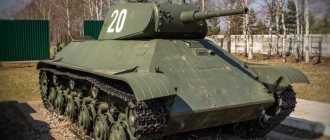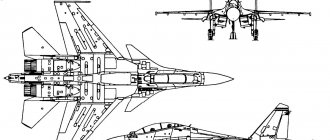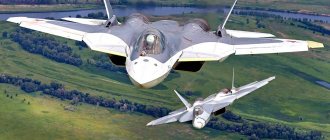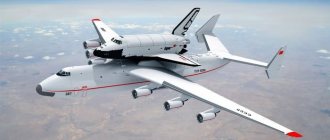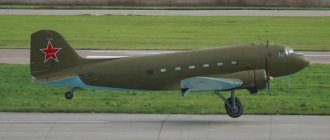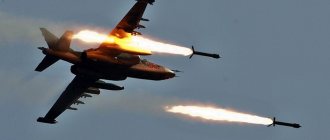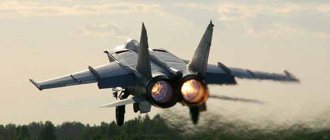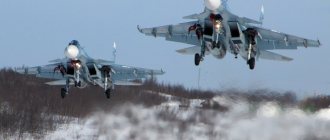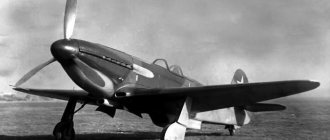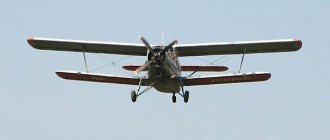MiG-31 - video
The MiG-31 is designed to intercept and destroy air targets at extremely low, low, medium and high altitudes, day and night, in simple and adverse weather conditions, when the enemy uses active and passive radar jamming, as well as false thermal targets. A group of four MiG-31 aircraft is capable of controlling airspace with a frontal length of up to 1,100 km.
Initially intended to intercept cruise missiles across the entire range of altitudes and speeds, as well as low-flying satellites. For several years, the MiG-31 regiments had the status of special forces (SpN) as part of the air defense.
History of creation
Work on the creation of the MiG-31 fighter-interceptor (product 83, E-155MP aircraft) began at the Design Bureau named after. A.I. Mikoyan in 1968. At the initial phase, the work was led by chief designer A. A. Chumachenko. Then, at the stage of deep engineering development and testing, - G. E. Lozino-Lozinsky. In 1975, after Gleb Evgenievich began developing the Buran, work on the creation of the aircraft was headed by Konstantin Konstantinovich Vasilchenko.
The combat capabilities of the fighter were supposed to be significantly expanded through the use of the latest electronic equipment, in particular, a passive phased array radar used for the first time.
The MiG-31 was built according to the design of the MiG-25 aircraft, but with a crew of two people - a pilot and a navigator-operator, located one after the other. The MiG-31 prototype made its first flight on September 16, 1975, with test pilot A.V. Fedotov at the controls.
On April 22, 1976, state joint tests (GST) of the MiG-31 began. The first stage of the GSI was completed in December 1978. The second stage began in September 1979 and ended in September 1980.
By decree of the USSR Council of Ministers of May 6, 1981, the MiG-31 fighter-interceptor with the RP-31 radar and R-33 missiles was put into service. Serial production began in 1979.
The MiG-31 replaced the Tu-128 interceptor.
Airframe design
The airframe of the MiG-31 aircraft was developed on the basis of the airframe of the MiG-25. The MiG-31 is designed according to a normal aerodynamic design with a high-mounted trapezoidal wing, a two-fin vertical tail and an all-moving horizontal tail.
The welded middle part of the fuselage, as on the MiG-25, is the main power element of the airframe, however, on the MiG-31 the proportion of stainless steel parts is reduced due to a decrease in the maximum speed of the aircraft and less heating of the power part of the structure. There are seven fuel tanks in the middle part of the fuselage. Fuel is also stored in four wing and two keel tanks.
The MiG-31 hull can create additional lift up to 25%, the missiles are semi-recessed into the hull. The share of steel is 50%, titanium - 16%, aluminum alloys - 33%.
The forward part of the fuselage is made of aluminum alloys and includes an electronic equipment compartment, a cockpit and a behind-the-cockpit equipment compartment; A radio-transparent radar radome is attached to the front of the nose.
The crew members are located in tandem, with the pilot in the front cabin and the navigator-operator in the rear cabin. Both cabins are sealed, separated from each other by a transparent plexiglass partition 10 mm thick; they are equipped with K-36DM ejection seats. Cabin canopies have movable segments that open upwards and backwards.
The three-spar wing with a sweep angle along the leading edge of 41° has a root bead with a sweep angle of 70°. An aerodynamic ridge is installed on the upper surface of each wing console. The wing has slotted flaps, ailerons and four-section deflectable leading edges along the entire length of the console with a deflection angle of 13°. On the external underwing pylons, two external tanks with a capacity of 2500 liters are suspended.
The consoles of the all-moving horizontal tail can be deflected both synchronously (for pitch control) and differentially (for roll control).
The two-fin vertical tail, installed with a camber angle of 8°, is equipped with rudders. Under the rear fuselage with a camber of 12° there are aerodynamic ridges.
The control system of the MiG-31 aircraft is mechanical. The garrot, located on top of the middle part of the fuselage, covers the wiring (cables and rigid rods).
On the lower surface of the fuselage in front of the niches of the main landing gear there are brake flaps, which simultaneously serve as landing gear doors. The main landing gear of the aircraft is equipped with a trolley with two wheels measuring 950x300 mm; move forward. The rear wheel of the main support is shifted outward relative to the front one.
The front landing gear is equipped with two wheels 660x200 mm; unlike the MiG-25, it retracts backwards.
Engines
The D-30F6 engines (1979) were developed on the basis of the civilian D-30 from the Tu-134 (1967), with an afterburner and nozzle, the engine is modular; the bypass ratio is 3.
The engine has a five-stage low-pressure compressor, a ten-stage high-pressure compressor, a tubular-annular combustion chamber, two-stage high and low pressure turbines. The maximum gas temperature at the turbine inlet is 1660 K.
The afterburner is equipped with rings that ensure combustion stability; the supersonic nozzle has special plate valves in the expanding part for air intake and elimination of pressure pulsations in the exhaust gas stream. To start the afterburner, the “fire track” fuel injection method is used. During the development process, the engine experienced vibration combustion in the afterburner; the problem was solved by installing a “fifth integrated manifold.”
The engine uses alloys of titanium, nickel and steel. Dry engine weight - 2416 kg.
Engine air intakes are side, with a larger cross-section compared to the MiG-25; the amount of air supplied to the engines is regulated by the lower flaps and the upper horizontal wedge automatically depending on the altitude and flight speed.
Weapon control system
The basis of the MiG-31 aircraft's weapons control system is a pulse-Doppler radar station (BRLS) with a passive phased array antenna (PFAR) RP-31 N007 “Zaslon” developed by the Research Institute of Instrument Making (Zhukovsky). The MiG-31 became the world's first fighter equipped with a phased array radar (PAR) and remained the only such serial fighter from 1981 to 2000 (until the French Dassault Rafale fighter entered service). For the first time in the world, a radar on a combat aircraft received three channels of operation, detection, target illumination, and determination of state ownership.
The A-50 and MiG-31 AWACS aircraft can automatically exchange target designation with each other. The MiG-31 can target ground-based air defense systems.
Airframe design
The MiG-31 is designed according to a normal aerodynamic design with a high-mounted trapezoidal wing, a two-fin vertical tail and an all-moving horizontal tail. The Mig-31 is practically the only aircraft capable of intercepting low-flying cruise missiles (including high-speed ones). Capable of hitting a satellite at an altitude of 120 km. Can intercept targets flying at speeds up to M = 5.
Radar "Zaslon"
RP-31 N007 “Zaslon” was developed by the Research Institute of Instrumentation (Zhukovsky). Entered service in 1981. The radar performs the following tasks: automatic detection and tracking of targets and guidance of missiles at them.
— Detection range of an air target of the “bomber” type (RCS = 19 m², with a probability of 0.5) in the front hemisphere: 200 km. — EPR 5 m² — 180 km. — Detection range of a fighter-type air target (RCS = 3 m², with a probability of 0.5) in the rear hemisphere: 35 km.
horizontally 140°, vertically from −60° to +70°.
— Number of detected targets: 24. — Channel for control center — 8, in addition, 4 priority ones are automatically selected. — The automatic tracking range is 120 km, as is the engagement range. — Detection of thermal targets: 56 km.
In particular (detection): F-16 - 120 kilometers, B-1B - 200 kilometers.
The angular zone of simultaneous missile fire on several targets for the MiG-31 is 18,200 square degrees (for the F-14 only 420 sq°).
Long-range missiles can be aimed at a target in a range of just under +/- 120 degrees (F-14 only +/- 20).
MiG-31BM from the 790th Fighter Order of Kutuzov III degree aviation regiment, Khotilovo airbase
Radar "Zaslon-M"
The project was completed in 1998, entering service with the troops in 2008. On the modernized MiG-31BM aircraft, the maximum detection range of air targets has been increased to 320 km, destruction - to 280 km, this is inaccessible to any other fighter, in comparison, the maximum destruction range of its closest competitor in terms of range, the F/A-18 Super Hornet, is 100 kilometers less . Up to ten targets are accepted for automatic tracking, and the latest Zaslon complexes track up to twenty-four targets and can simultaneously attack up to eight targets. The Argon-K on-board computer (Argon Research Institute) selects the four most important of them, which can be simultaneously targeted by four long-range R-33 (R-33S) air-to-air missiles.
The longest detection range for a target with an EPR of 20 m² is 400 km, for an EPR of 5 m² - 282 km.
An additional means of detecting air targets is the 8TP heat direction finder, which is located under the forward part of the fuselage (detection range, depending on the state of the atmosphere and the degree of “heating” of the target, is up to 56 km). In the flight position, the heat direction finder is retracted into the fuselage, and in the working position it is released into the flow. It is interfaced with a radar and is designed for passive surveillance of the airspace, as well as for issuing target designation to R-40TD and R-60 missiles with TGS.
The flight and navigation equipment of the MiG-31 aircraft includes the automatic control system SAU-155MP and the sighting and navigation complex KN-25 with two inertial systems IS-1-72A with a digital computer "Maneuver", a radio engineering short-range navigation system "Radical-NP" (A -312) or A-331, long-range navigation radio system A-723 “Kvitok-2”. Long-distance radio navigation is carried out through two systems: “Tropic” (similar to the “Loran” system) and “Route” (analogous to the “Omega” system). The onboard defense complex includes the SPO-15SL radar warning receiver and electromagnetic and infrared jamming equipment.
The aircraft is equipped with electronic warfare systems in the radar and infrared ranges. The MiG-31 interceptor is capable of performing combat missions by interacting with a ground-based automated digital control system (ACS "Rubezh"), operating in remote guidance modes, semi-autonomous actions (coordinate support), alone, and also as part of a group of four aircraft with automatic intra-group exchange information. The digital noise-resistant communication system ensures the automatic exchange of tactical information in a group of four interceptors, remote from one another at a distance of up to 200 km (for ground points, the range is up to 2000 km) and targeting of a group of fighters with less powerful avionics (in this case, the aircraft performs the role of a guidance point, or repeater). The MiG-31 is capable of targeting up to four Mig-23/29 and Su-19/27 aircraft without turning on the radars of these aircraft. It is the only combat aircraft capable of effectively intercepting small, low-flying cruise missiles. The AK-RLDN digital noise-resistant radio channel provides two-way exchange of tactical information with the ground command post. Digital noise-resistant equipment APD-518 allows you to exchange data on the air situation at a distance of up to 200 km with aircraft that have interface devices with APD-518 equipment (MiG-31, Su-27, MiG-29, A-50). It is possible to restore a complete picture of the air situation obtained from the results of the operation of four radars and restore information using triangulation or kinematic methods. All this makes the Mig-31 not just an interceptor, but also a flying headquarters for the Air Force and Air Defense, and at the same time serves as an AWACS.
Fundamental differences between the MiG-31BM version
The MiG-31BM airborne radar system is capable of simultaneously detecting up to twenty-four air targets, eight of which can be simultaneously fired at by R-33S missiles. Other characteristics of the complex have been improved.
Upgraded versions of the aircraft can be equipped with Kh-31P, Kh-25MP or X-25MPU anti-radar missiles (up to six units), X-31A anti-ship missiles (up to six), Kh-29T and Kh-59 air-to-surface missiles (up to three) or X-59M (up to two units), up to six KAB-1500 adjustable aerial bombs or up to eight KAB-500 with television or laser guidance. The maximum combat load weight is 9000 kg.
JSC Russian Avionics has developed a fundamentally new layout of both cabins for it. The main disadvantage of the previous configuration was the pilot’s lack of information about the tactical situation: the commander did not know what the navigator was doing. Now in the front cockpit, on the right side of the instrument panel, a 6x8-inch multifunctional LCD indicator (similar to that used on the MiG-29SMT) is installed. The navigator-operator's cabin has undergone more significant changes, in which there are three such indicators, on which a wide variety of information can be displayed (tactical, navigation, radar, images from television cameras of guided weapons, etc.). The aircraft also received an indicator on the windshield, replacing the previous PPI.
The navigation system, which is equipped with the modernized MiG-31BM, is largely unified with the MiG-29SMT (it includes a satellite navigation receiver). As a result of the modification of the fleet of MiG-31 fighters, the domestic air force received an almost new aircraft with a wide range of combat applications. The target speed corresponds to M = 6.
The export version of this fighter, the MiG-31FE, can install and integrate with Russian systems Western-made weapons and equipment.
The service life of the aircraft after major repairs and modernization to the BM level is at least 15 years.
Range of flight
For a MiG-31 with four missiles and two drop tanks, launching missiles midway, dumping drop tanks after they are used up, and a secondary missile launcher, the subsonic practical range and flight duration are 3,000 km and 3 hours 38 minutes, respectively.
Subsonic practical range and duration without drop tanks and retracted secondary battery is:
- without missiles: range - 2480 km, duration - 2 hours 44 minutes; - with four missiles and launching them midway: range - 2400 km, duration - 2 hours 35 minutes; - with four missiles: range - 2240 km, duration - 2 hours 26 minutes.
In 2013, the crews of the 14th Air Force and Air Defense Army of the Central Military District on MiG-31BM fighters set a record for the duration of a non-stop flight on MiG-31BM fighters, spending 7 hours 4 minutes in the sky. The flight range was more than 8,000 km with three in-flight refuelings.
Modifications
Since the release of the MiG-31, numerous modifications of the aircraft have also been developed:
MiG-31B - Serial modification of the MiG-31, equipped with an in-flight refueling system; entered service in 1990.
MiG-31BS - MiG-31, upgraded to the level of the MiG-31B, without an in-flight refueling boom.
MiG-31BSM - Modernization of the 2014 MiG-31BS without an in-flight refueling boom.
MiG-31BM - Modernization in 1998, a modern version of the MiG-31 for the Russian Air Force. It is planned to upgrade 60 MiG-31 to MiG-31BM by 2022. The first stage of the State Survey was completed in 2008, the second stage in 2012.B. The upgraded aircraft will receive a new weapons control system and radar, which will allow them to detect targets at a range of up to 320 kilometers and simultaneously track up to ten air targets.
MiG-31D - Experimental modification capable of carrying the 79M6 Kontakt anti-satellite missile. Not mass produced.
MiG-31DZ - Serial fighter-interceptor equipped with an in-flight refueling system (the location of the in-flight refueling system is similar to the MiG-31B). REO (radar) equipment cannot be upgraded to a BM product. After modernization, the DZ index does not change, the equipment remains unchanged.
MiG-31I (Ishim product) - The aircraft is designed for air launch of small spacecraft weighing 120-160 kg into orbits of 600-300 km.
MiG-31LL - Flying laboratory in Zhukovsky.
MiG-31M - Interceptor fighter upgraded in 1993 with enhanced weapons, radar, and avionics; had a characteristic “rounded outward” shape of root nodules. Not mass produced.
MiG-31F is a multi-role front-line fighter, also designed to attack ground targets (a project for a fundamentally new aircraft).
MiG-31FE - Export version of the MiG-31BM aircraft. Not mass produced.
MiG-31E - Export version with simplified avionics. Not mass produced.
Russian Air Force MiG-31DZ at Khotilovo airbase
Exploitation
The first interceptors began to enter the air defense forces in 1980. In 1981, production of the MiG-31 began in Gorky. The first series consisted of only two aircraft, the second - of three, the third - of six. All these aircraft were intended for flight testing. New interceptors began to enter air defense service in 1983.
The first MiG-31s were received by the 786th IAP, stationed in Pravdinsk, and the Air Defense Combat Use Center in Savasleika. In air defense units, the MiG-31 replaced the Su-15 and Tu-128. In September 1984, new interceptors began combat duty in the Far East - at the Sokol airfield, Sakhalin Island.
Production of the MiG-31 was discontinued in 1994. By the end of 1994, more than 500 MiG-31 and MiG-31B aircraft were built.
During the 2nd Chechen War, MiG-31 and A-50 AWACS aircraft controlled the airspace of the Chechen Republic.
At the moment, the aircraft in service are being modernized to the MiG-31BM version; the first two entered service with the troops in 2008.
In 2008, the first stage of the MiG-31BM GSI was completed, the second is ongoing.
It is known that 60 MiG-31s will be upgraded to the BM version; according to Zelin, 30-40 MiG-31s in the DZ and BS modifications will also remain. The remaining MiG-31s (about 150 units) are planned to be written off.
On August 8, 2014, during a visit to the Nizhny Novgorod aircraft manufacturing plant, Deputy Prime Minister Dmitry Rogozin proposed resuming production of the fighter.
What's new in the BM modification
In the early 2000s, the MiG management approached the new government apparatus with a proposal to continue work on modernizing the MiG-31 and received a positive response. It is important that the military department decided to maintain the purpose of the main combat missions, and the interceptor did not become another version of a multirole fighter. There was a demand from the Aerospace Forces to improve the characteristics of its predecessor in intercepting targets, as well as to ensure the ability to qualitatively modernize a large fleet of aging vehicles with on-board electronics, software and weapons.
Many enterprises and scientific institutes got involved in the work, some of them are widely known in the country - these are the Vympel Design Bureau, the Chkalov GLITs, the Tikhomirov Research Institute of Instrumentation, and the Sokol plant. The instrument makers were pleased with the development of the Zaslon-AM weapon control system (WCS), working with the modernized RP-31AM radar, and the unique calculating rig computer, with special software (software). These capabilities of the new Zaslon make it possible to find stealthy targets with an EPR of 3 m2 (4th generation fighters) at a distance of 320 km and hit them at 280 km.
Russian satellite navigation GLONASS installed. The probability of hitting hypersonic targets and cruise missiles has doubled. The aircraft became 1.5 to 4 times more effective in combat. Its radars show 5th generation stealth aircraft before entering close combat, which will make F-22 pilots think about their impunity. The first display of the MiG-31BM took place in 2007 at the MAKS exhibition. After the interceptors were finalized, two aircraft were already seen in 2008; while flying over the military airfield in Savaslake, the pilots of the 3958th Kerch Guards Red Banner Aviation Regiment gave them a good description. The interior of the cabin was preserved to the maximum, only a monitor was added.
Since 2006, Mikoyan Design Bureau has had a long-term contract with the Russian Ministry of Defense. Production of serial aircraft has been ongoing since 2009. Until 2016, the project was being finalized and production was limited. By 2020, at least 60 more MiG-31 winged aircraft will be added, updated to the BM modification.
Read Tu-160 White Swan
Performance characteristics of the MiG-31
MiG-31 crew
— 2 people
Dimensions of MiG-31
— Length: 22.69 m — Fuselage length: 20.62 m — Wingspan: 13.46 m — Height: 6.15 m — Wing area: 61.60 m² — Chassis base: 7.11 m — Chassis track: 3.64 m
Weight of MiG-31
— Empty weight: 21820 kg — Fully fueled weight: 39150 kg — Maximum takeoff weight: 46750 kg — Fuel weight: 17330 kg — Payload weight: up to 5000 kg
MiG-31 engine
— Engine: 2 × TRDDF D-30F6 — maximum thrust without afterburning: 2 × 9500 kgf — thrust with afterburner: 2 × 15500 kgf — engine weight: 2 × 2416 kg
Maximum overload of MiG-31
- 5G
Speed of MiG-31
— Maximum permissible speed at low altitude: 1500 km/h — Maximum permissible speed at high altitude: 3700 km/h (M=3.1) — Subsonic cruising speed: 950 km/h (M=0.9) — Supersonic cruising speed: 2500 km/h (M=2.35) — Landing speed: 280 km/h
MiG-31 flight range
- at an altitude of 10000 m, at M=0.8: 1450 km - at an altitude of 10000 m, at M=0.8 without refueling with 2 tanks: up to 3000 km - at an altitude of 10000 m, at M=0.8 with one refueling: up to 5400 km - at an altitude of 18000 m, at M=2.35: 720 km - Combat radius: 720 km - Flight duration: up to 3.3 hours - Service ceiling up to 30000 m (dynamic); up to 20600 m (practical)
Thrust-to-weight ratio of MiG-31
— with full fuel: 0.79 — at maximum take-off weight: 0.66
— Rate of climb at the ground 160 m/s; at supersonic speed, at H = 11 km 250 m/s — Takeoff: 950–1200 m — Mileage: 800 m
Armament of the MiG-31
One of the weapon kit options:
— one 23mm GSh-6-23M cannon (260 rounds); - combat load - 3000 kg; — 4 long-range missiles R-33; — 2 medium-range missiles R-40T; — 4 short-range missiles R-60. R-60M.
Cannon armament of the MiG-31
— 1x23mm GSh-6-23 ammunition load of 260 shells; — rate of fire at low speed: no less than 8000/min., at t = −60 °C: no less than 6400/min.
Missile armament of the MiG-31
— The missiles are placed on six hardpoints (additionally two hardpoints for the PTB): four points on the hull and four on the pylons on the wings allow, depending on the specific ammunition used, up to four long-range missiles + up to four more medium or short-range missiles ( including four long-range and four medium R-77 missiles);
MiG-31 air-to-air missiles
— long-range: four P-33s up to 304 km (2012), six P-37s to combat targets maneuvering with an overload of up to 8G P-33s with a range of 120 km (1981) and P-33S 160 km (1999); - medium range: two, R-40, since 1999 only R-40RD has been used, range 80 km, missile speed 4.5-5Mach, target altitude 0.5-30 km, target maneuvering 4G, four R-77, range 110 km, target maneuvering 12G; — short-range: four R-60(M), four R-73 infrared spectrum.
Fire is possible by air-to-surface means. Laser-guided bombs weighing 500 kg, as well as anti-radar/anti-ship missiles Kh-31P (up to 160 km), Kh-58, maximum payload weight is 9000 kg.
Interceptor fighter design
The appearance and design of the MiG-31 aircraft was seriously influenced by one of the best aircraft of that time - the MiG-25, which was discontinued due to Belenko's escape. Structurally, the 25th had enormous potential for development.
It was used by the designers of KB-155, who developed the MiG-31 as a basis.
Main characteristics of the interceptor design:
- trapezoidal wing located in the upper part of the body
- all-moving stabilizer
- normal aerodynamic design
- “branded MiG” two-keel tail of the vehicle.
The MiG airframe also received major changes affecting the alloys used for the hull. 50% was stainless steel versus 80% for the MiG-25. 33% were made from aluminum-based alloys, 16% of the case was made from titanium, 1% from other materials. This layout made it possible to significantly reduce the weight of the airframe, making it possible to use the lifting capacity resource to greater advantage.
The design of the vehicle included a large number of fuel tanks. In total, the design contained 17,330 kilograms of fuel, distributed between 7 tanks in the fuselage, 5 tanks in the wings and 2 keel tanks. If necessary, additional tanks are suspended under the wings, 2 containers of 2500 liters each.
An important change was the installation of a gargrot in the middle part of the fuselage, on top. This provided advantages both in protecting vital control elements and in streamlining the fuselage. By the way, the controls on board are mechanical, and the garrot perfectly protects the rigid rods and wiring on this machine.
However, the 31st also had some differences from its predecessor. Thus, some of the stainless steel parts on the body were removed from the new interceptor. This was due to a decrease in heating in the power part of the fuselage body.
In addition, the MiG-25 was a single-seat aircraft, while the 31st received, in addition to the pilot, also a navigator-operator, who was located behind the pilot.
Connected with this is a joke popular among pilots that after Belenko’s flight, a “special officer” will accompany the pilot on each flight. Of course, this is just a joke.
The new car had sophisticated radio equipment, which would be difficult to handle alone. The navigator-operator performed the tasks of monitoring space in the air and, using instruments, developed tactical techniques necessary to intercept and destroy group targets.
Photo of MiG-31
MiG-31BM cockpit
Chassis and braking system
The design of the MiG-31 fighter chassis also deserves special attention.
The board lands on a three-post structure. The front chassis is reinforced with two pneumatic mechanisms and consists of two wheels measuring 660x200 mm.
An important difference from the MiG-25 is that the front landing gear is now retractable. The side landing gear located in the lower part of the fuselage is made in the form of two-wheeled trolleys.
The wheel size is 950x300 mm, they move forward. An interesting solution is that the landing gear brake flaps simultaneously serve as flaps.
The MiG-31 chassis allows this vehicle to land on any runway of acceptable quality. Ice or soil, of course, is not the best runway for an interceptor fighter, but it is capable of being based at such airfields.
This is extremely important in the operating conditions of the 31st in sparsely populated areas of Siberia and the Far East, which are not spoiled by infrastructure.
The design also includes a container with a braking parachute at the rear of the fuselage.
History of creation
The creation of the MiG-31 began in 1968 at the Experimental Design Bureau named after. A. I. Mikoyan.
The aircraft's combat capabilities were planned to be significantly increased with the help of electronic equipment, for example, a phased passive array radar. The fighter was made according to the MiG-25 design, but the differences were in the number of crew, two people, a navigator-operator and a pilot. These specialists were located in a tandem arrangement. The prototype of the aircraft took off in the fall of 1975.
In the spring of next year, the fighter began state tests. Their first stage ended two years later. The second stage lasted in 1979-1980.
In the spring of 1981, the MiG-31 was put into service.
Engine and speed potential
The power plant of the device is represented by two D-30F6 engines. This sample is double-circuit: the inner and outer circuits mix the flows behind the turbine.
The characteristics of each of the two engines impress even competitors of the 5th generation fighters:
- 9270 kgf non-afterburning thrust at maximum capabilities;
- 15510 kgf similar afterburner thrust
- 2420 kg dry weight.
The engines allow the sample to reach a maximum speed of about 3000 km/h. This indicator is the best among similar aircraft of domestic and foreign production.
But the main surprise is that it is capable of developing supersonic speeds not for a short time (for example, 15 minutes for the Su-35), but for a time literally limited by fuel reserves. Taking into account the fact that an L-shaped bracket has been developed in the nose for in-flight refueling, the sample has inexhaustible potential.
Russian pilots set a record for being in the air with this aircraft. It took 7 hours 4 minutes, covering 8000 km, which is nonsense for fighters.
Cabin equipment
The navigator-operator is equipped with advanced electronic devices, the likes of which are unique in almost all similar aircraft in the world. The tactical situation and navigation equipment are broadcast on a large indicator. Thus, the operator is able to monitor all possible situations in the sky.
A color indicator is mounted in front of the pilot, displaying virtually every aspect of the aircraft's technical data in flight. Scales, indices, and benchmarks provide a comprehensive analysis for further actions of the crew.
For the safety of pilots, ejection seats are installed. Unfortunately, they are sometimes vital.
There have been several crashes with aircraft of this series for various reasons. And fortunately, the ejection system saved the lives of the pilots.

